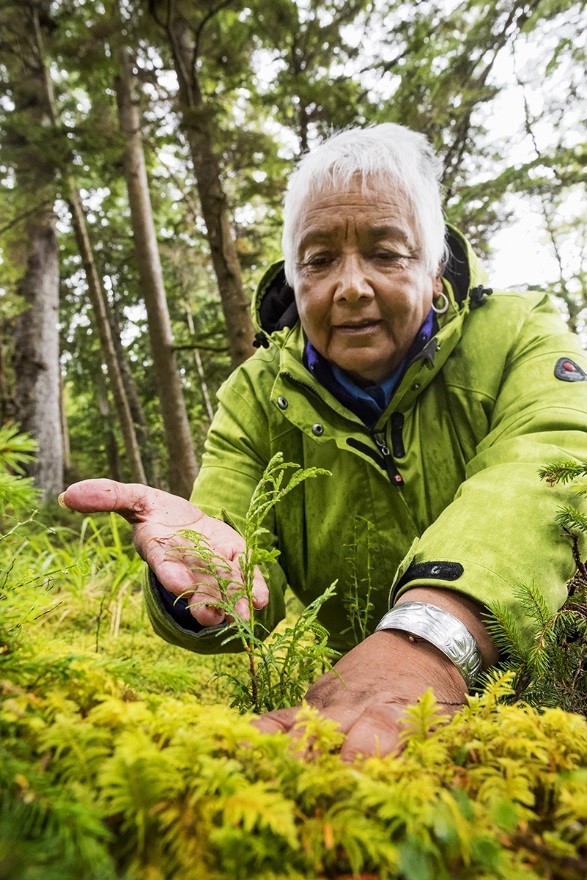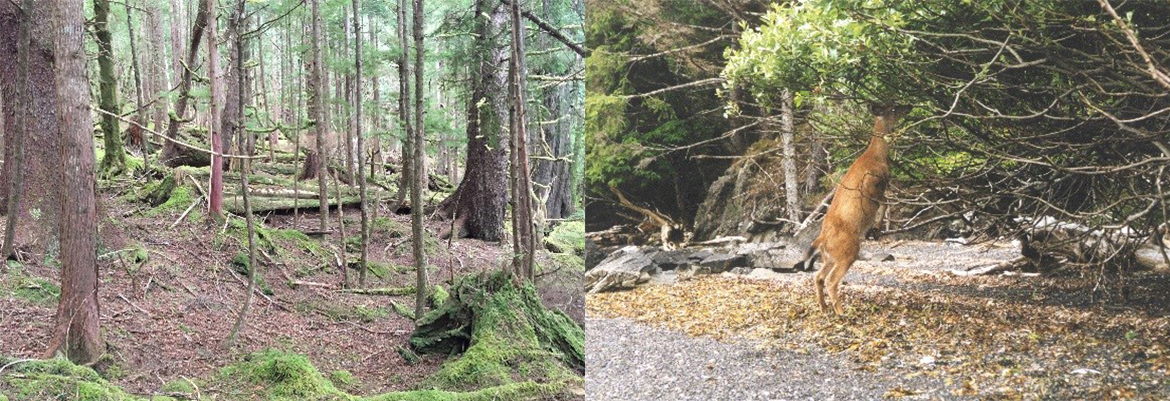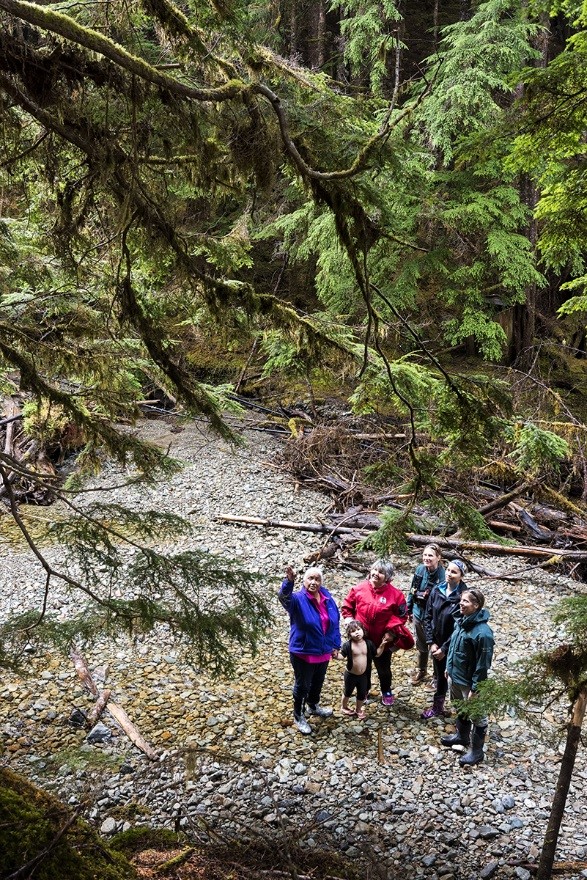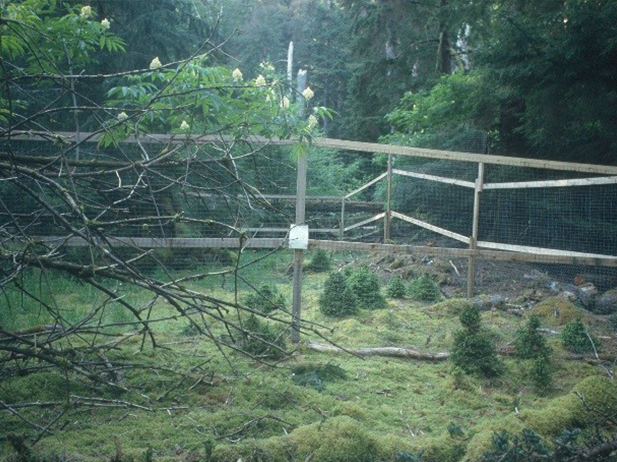
How to Pronounce Llgaay gwii sdiihlda in Xaayda Kil
This translates to "Restoring Balance"
If you have visited Gwaii Haanas chances are you have seen a Sitka black-tailed deer. These seemingly harmless deer were introduced to Haida Gwaii in the late 1800s. They migrated into Gwaii Haanas throughout the 1900s. This invasive species has browsed their way through intertidal zones and the forest understory, eating culturally important plant, tree, and bush species.
In March 2017, Parks Canada and the Haida Nation, plus other partners, embarked on a large-scale ecosystem restoration project in Gwaii Haanas called Llgaay gwii sdiihlda - Restoring Balance. The project was initiated to restore the natural and cultural plant species decimated by years of deer browsing.To learn more about this project please contact Nadine Wilson at nadine.wilson@pc.gc.ca
Native plants ecological and cultural importance

© Andrew S. Wright
There are many plant, shrub and tree species located in Gwaii Haanas that are ecologically important to native animals, and culturally important to the Haida people.
The diversity of plants, shrubs and trees provide food and shelter for many animals. Together, they help make up the complex habitats many animals on Gwaii Haanas need to survive.
T’suu (cedar) plays a huge role in Haida culture and is one of the species of importance recognized in the Haida Land Use Vision (2005) (PDF, 1.1 MB).
Cedar trees are important to many other living things great and small. They provide habitat for forest creatures, some of which are an important feature of Haida crests and histories…
When a Haida person goes for bark, a pole or a canoe, trees are approached with respect. Their spirits are hailed in a song and thanked with prayer. A bark gatherer takes care that the tree will go on living.
Other species, such as Hldaan (blueberry), Ts’iihlinjaaw (devil’s club) and Kayd (Sitka spruce), are used as medicine, food, building or artistic materials by the Haida people.
The threat of an invasive species
When forest ecosystems are over-browsed, plant and animal populations suffer. Over-browsing causes ecologically and culturally important plant and animal populations to shrink. It could also lead to them disappearing forever. The large deer population and over-browsing has negatively affected cedar on many islands in Gwaii Haanas. Many bird and invertebrate species flee the delicate island ecosystems over-browsed by deer.
According to the Gwaii Haanas Gina ‘Waadlux̱an KilG̱uhlG̱a Land-Sea-People Management Plan 2018 the largest threat to terrestrial ecosystems and cultural plants are introduced species such as k’aad deer.
Ecosystem improvements cannot take place without a significant decrease in deer populations. Deer can be found on most of the 150-plus islands in Gwaii Haanas. Only a small handful of islands such as Tar, Agglomerate and Lost Islands are deer free most of the time. On the rest of the islands in Gwaii Haanas, deer populations grow unchecked with minimal threat from predators, as a result the forest understory is overbrowsed by k’aad as populations grow. As the understory disappears, so does the biodiversity. Unless deer are removed from the ecosystem, damage to plants, the soil and seabirds will continue to grow.

Left: A Sitka black-tailed deer browses some shrubs. ©Andrew S. Wright
Right: A barren moss wasteland on Ramsay Island. ©C.Gill/Coastal Conservation
Restoring for future generations

In 2014, a restoration plan was developed and approved by the Archipelago Management Board. The project, Llgaay gwii sdiihlda - Restoring Balance, was then implemented between 2017 and 2019. Llgaay gwii sdiihlda aimed to re-establish native flora and fauna by removing browsing pressures of introduced, invasive Sitka black-tailed deer from select islands. This included Xiina Gwaay.yaay (Ramsay Island) and surrounding islands Kingts’ii Gwaay.yaay (the Bischofs), Daa.a Gwaay (Faraday), Gaysiigas Gwaay (Murchison), Gandll K’in Gwaay.yaay (Hotspring), and Aataana Gwaay.yaay (House).
The project also included the reduction of deer along the southern shore of Lyell Island and Moresby Island. Hunting on SG̱aay Taw Siiwaay K’adjuu (Moresby) and Tllga Kun Gwaay (Lyell Islands) was meant to reduce the likelihood of deer swimming over to the project islands. During early planning the Archipelago Management Board consulted with the BC/Yukon SPCA. They were invited to review the operational plan and provide feedback to ensure the humane treatment of the animals.
By removing deer from this chain of islands it would allow the creation of a large area where shrubs, medicinal plants, bushes and trees, especially red cedar and yellow cedar, could thrive. Wildlife such as Northern Goshawk, Ancient Murrelets and Saw-Whet Owls would also benefit.
Additionally, this project provided venison, hides and hooves to local communities. As much as possible, the deer were harvested and processed locally to go to Haida Gwaii community food programs, such as the Local Food to School and elder day programs. Venison was distributed to Haida Gwaii elders’ homes. Deer hooves and hides were also distributed and used for Haida cultural purposes.
2017 – Starting Restoration
The first phase of the project was completed in 2017. It required traditional Haida knowledge, local skills and international expertise. Partners, who specialize in preventing native species extinctions by removing invasive species from islands, were also key to the project’s success.
Multiple methods were used to eradicate deer from the islands. Bait stations were used as the first method. Corn, cedar and apples were used to attract deer to the bait stations so they could be taken at set times and locations on Ramsay Island. This was followed by dog-assisted ground hunting and aerial shooting from a helicopter. Shoreline hunting happened throughout the project by experienced Gwaii Haanas marksmen.
Parks Canada and partners such as the University of British Columbia are also monitoring Ramsay Island soil conditions, plant regrowth and seabird populations. In 2017, a team of scientists from the University of British Columbia travelled to Ramsay Island to measure vegetation growth and track nutrient cycles. Records were made by checking the state of the forest soil, carbon and nitrogen balance and the above ground shrub diversity. Data was also collected for two years before the start of Llgaay gwii sdiihlda, and continued until 2019. Multiple years of recorded data before and after the deer were removed will help assess health of the forest ecosystems on Ramsay Island.
By September 2017, a biosecurity plan was put in place. The biosecurity plan describes next steps and ways to maintain deer-free on the project islands. Methods include prevention, detection and response and ongoing infrared camera monitoring.
The benefits/results of 2017
A total of 598 deer were removed during the project in 2017. This included over 400 from Ramsay Island. All known invasive deer were removed from Bischofs, House, Hotspring and Murchison islands. A small number of deer remained on Ramsay and Faraday Islands.
Additional benefits included:
- The opportunity to learn and share information with national and international partners was invaluable. Gwaii Haanas team members, including three Haida, received marksmenship training from internationally renowned invasive species eradication experts. In turn, the Gwaii Haanas team contributed knowledge and expertise to the international invasive species conservation field of knowledge.
- Deer fit to harvest were processed and donated through a community food distribution program. Venison was distributed to seniors, school children and community groups across Haida Gwaii in 2017 and 2018.
- Deer hides and hooves were donated to local community groups to use in Haida regalia making workshops for youth and cultural programs. The regalia was danced into the world at a special event in May 2018.
- The forests of Ramsay Island have been regenerating. New sprouts and suckers on many important native plant species have been observed. This includes devil’s club, crab apple, spruce and huckleberry.
- There have also been positive impacts to seabird habitat. Plants have been able to ‘green up’ more than they have for the last fifty years. This has increased habitat complexity and cover.
2018-2020 – Monitoring and collaboration
In 2018, ongoing monitoring and data analysis took place to help make sure no new deer moved onto the Restoring Balance islands. A trip to SGang Gwaay – a Haida Heritage Site and UNESCO World Heritage Site - also took place to lower deer populations there to protect the world renowned village site.
Faraday Island, became the primary focus to continue deer removal in spring 2018. To confirm if any deer were left on the island, extensive grid searches were planned. These grid searches would tell if a hunt needed be conducted by Gwaii Haanas trained marksmen and CHN staff. The teams hunted on Faraday Island, Murchison, House and Hotspring.
In 2018, 2019 and 2020, vegetation plot surveys continued on Ramsay to track record information on what plants were found over time at various locations.
In 2019, strategic, small scale deer hunts took place in key locations to obtain DNA samples. Deer DNA was collected thanks to donations by local hunters to a local abattoir. The DNA was sent to the University of British Columbia, Okanagan genetics lab where deer movement and family webs (how related deer were to each other) would provide information to plan future management in Gwaii Haanas.
In 2020, deer scat was gathered from SGang Gwaay and surrounding islands to be sent to the University of British Columbia, Okanagan genetics lab to be added to the Gwaii Haanas deer genetics library.
In 2020 – the Gwaii Haanas Archipelago Management Board hosted an Invasive Alien Species (IAS) Symposium that was attended by land and resource managers from the Haida Nation, Ministry of Forests, Lands, Natural Resource Development and Rurual Development, Parks Canada, Birds Canada, Coastal Conservation and many more. The purpose of the IAS symposium was to discuss the impacts of introduced, invasive rats, raccoons, deer and beaver to Haida Gwaii ecosystems and culture. The symposium also featured lessons learned and success stories from other island invasive species experts in places such as Mexico and Italy.

©C.Gill/Coastal Conservation
Next steps
The first phase of Llgaay gwii sdiihlda is complete and now ongoing annual monitoring and maintenance is taking place. The next step in this forest regeneration project includes analyzing what we’ve gained.
Parks Canada continues to study the changes taking place. Monitoring new forest growth will continue, providing deeper understanding of how these trees, plants and shrubs respond without invasive deer.
Additionally, as more time passes and deer management continues in Gwaii Haanas, these benefits are expected to occur.
- This project will enable the creation of a traditional medicine cabinet with diverse and culturally significant plants. Haida people will be able to access more traditional medicinal plants as the forest understory grows back.
- As cedar saplings regenerate it will allow for monumental cedar growth for future generations, thus contributing to the Council of the Haida Nation’s Land Use Vision.
- Ecological processes and ecosystem resiliency will continue to strengthen Temperate rainforest inhabitants such as native birds, mammals, amphibians, and invertebrates can return.
Plants of cultural significance predicted to recover:
- Ts’uu - Red Cedar
- Kayd - Sitka Spruce
- K’aang - Hemlock
- Ts’iihlinjaaw – Devil’s Club
- SGiidllGuu - Huckleberry
- Hldaan – Blueberry
- Sk’idGan – Salal
- K’ay – Crab Apple
- Sgan sgawan – Skunk Cabbage
Program partners
The main partner in Llgaa gwii sdiihlda is the Council of the Haida Nation as co-operative management partners of Gwaii Haanas. The Gwaii Haanas Archipelago Management Board directs the project with management and operations decisions.
Other project partners include:
- Coastal Conservation
- Island Conservation
- Research Group on Introduced Species (RGIS)
- Pacific Institute for Climate Solutions
Come and see for yourself
Left: The Kunga plant enclosure in 1998, © RGIS.
Right: The Kunga plant enclosure in 2016. © Parks Canada / B. Catto
People can learn about the effects of introduced, invasive Sitka black-tailed deer thanks to three cultural plant enclosures: in the front country on the Spirit Lake Trail in Skidegate and in Gwaii Haanas on Kunga Island and at the Haida Gwaii Watchmen Site Hlkyah GawGa/Windy Bay.
The native plant enclosure on Kunga Island, near T’aanuu Llnagaay, is one of the best places to visit on Haida Gwaii to get a sense of how well the forest understory can recover without the threat of overbrowsing by Sitka black-tailed deer. In 1998, a fenced in area was built to keep deer out and see how many plants and animals have come back including huckleberry, cedar, spruce and elderberries. If the regrowth at Kunga is anything to go by, the forests of the Restoring Balance project will flourish.
Want to learn more about our other ecosystem restoration projects? Visit:
- Date modified :









